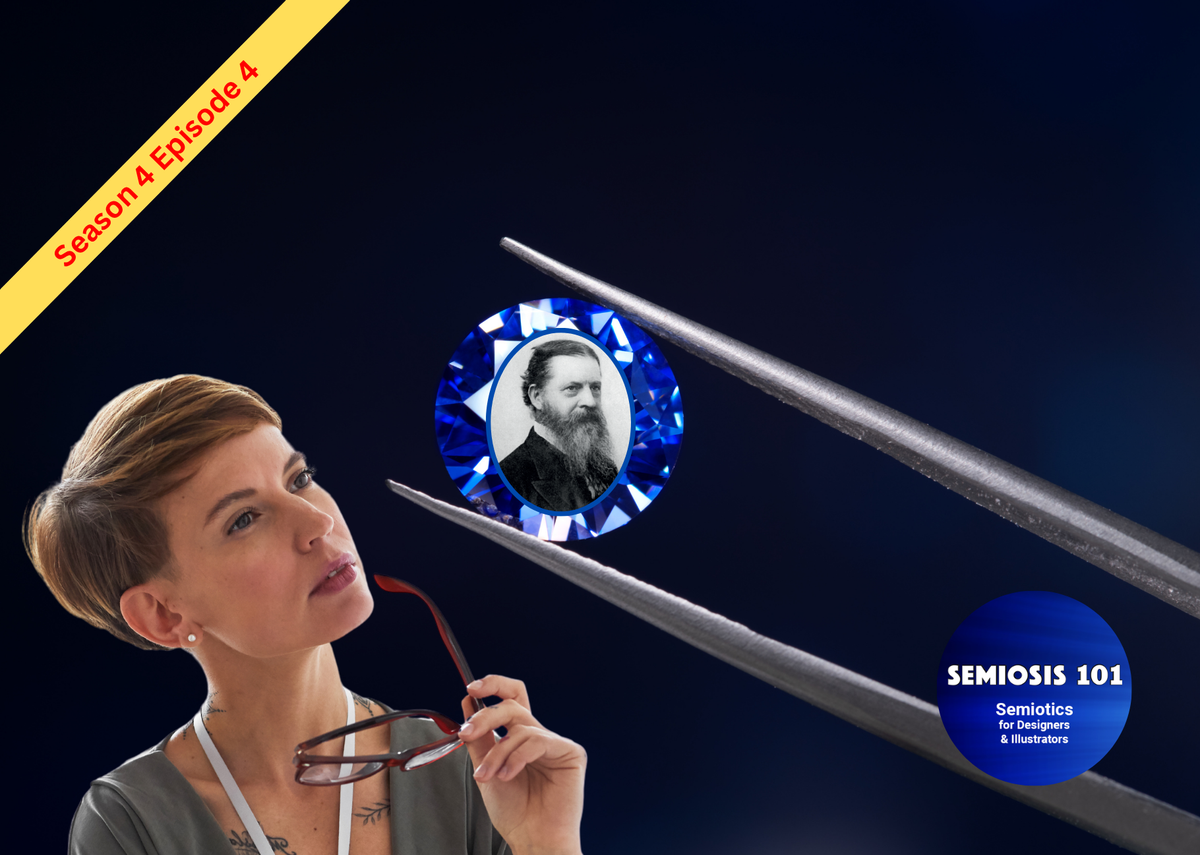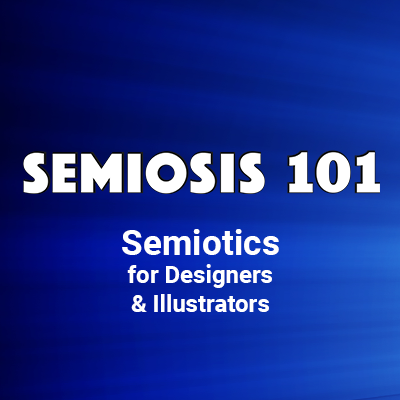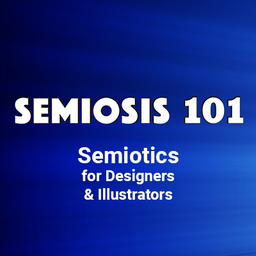Free Semiosis 101 Transcript 4.4:

How Will Our Creativity Benefit from Audience Perceptions?
Hello readers.
In this free transcript for the episode 4.4 published on Semiosis 101 on Weds 16 Apr 2025, we will become a semiotic Sherlock Holmes in this 4th episode of Semiosis 101’s season four, as we further explore the clues our target audience can provide us to help them. Meaning is always visually dormant until perceived as meaningful. Semiosis’ semiotic determination flow between concept > representation > interpretation does not end at interpretation. What does the representation really represent?
Watch the free episode on YouTube for the full impact…
…and here is the episode’s transcript.
How Will Our Creativity Benefit from Audience Perceptions?
Peirce says nothing is a semiotic sign until interpreted as a sign for something. Your creative decisions can be enhanced by understanding your audiences’ perspectives and lived experiences. Your audience can provide you tantalising clues on how to ensure you visually communicate what you intend.
Let us now explore how Peirce’s semiotic sign-action (Semiosis) helps you to benefit from this…
We will become a semiotic Sherlock Holmes in this 4th episode of Semiosis 101’s season four. We investigate the cultural clues which our target audience can provide us with to how they will interpret. Last episode I left you all with the realisation that semiotic signs are not single-use.
Semiotic signs are always in plain sight within any design or illustration. Encoded semiotic signs initially lie dormant until perceived, and can release deeper meaning. Semiosis’ determination flow cycles between concept > representation > interpretation >. This semiotic sign-action flow is not linear but helical. Each interpretation the audience makes from perceiving what is represented, unlocks a facet of the concept being visually communicated.
Your visual language decisions are meaning-bearing visual elements. Encoding semiotic sign-action begins with weak semiotic qualities. These semiotically trigger audience perception through familiarity, to suggest the concept. Historically semiotics in the creative industries has been applied analytically as a post-production tool. Thankfully, in recent years there has been major inroads by semioticians to seek ways to apply semiotic theory.
Semiosis 101 is on a slightly different tack. I am a practitioner first and semiotician second. Plus I obviously advocate Peirce’s Pragmatic semiotic theory over Saussure/Barthes. A criticism of semiotics within design is one of “semiotisation.” Klaus Krippendorff argues, in the context of design artefacts that, “if designers of artifacts were to conceptualize the meanings of artifacts in semiotic terms (…invites…) ‘pretentious semiotizations,’ deceptions of the users” regarding the artefact’s nature.
I do not intend to enter this debate directly. My practitioner-led designer-centric focus on Peirce’s theory is not a semiotisation of intended meaning. Semiosis is not first-order thinking. As I have laid out, Semiosis is dependent on the audience to be successful. Meaning is semiotically encoded and released through helical circuits of interpretation of the representation of the concept.
A creative will use their visual language to visually communicate the intended concept through their aesthetic. However, this is not semiotisation as Krippendorff frames it. Nor is it a post-production analytical deconstruction. Semiosis is semiotic sign-action between creatives and the audience. So let us move beyond “semiotisation” or “deconstruction” to actual semiotic sign-action.
As Peirce clearly states, nothing is a semiotic sign until interpreted. The visual language a creative uses to visually communicate the concept a client desires, is rich in semiotic signs. Whether the creative is aware of encoding them or not. Any meaning these signs suggest remains dormant. Meaning is always dormant until perceived as meaningful.
The cycle of Semiosis between concept > representation > interpretation does not end at interpretation. What does the representation represent? Seldom will meaning come fully formed in a single cycle through this semiotic determination flow. Interpretation will, if successfully visually communicated, lead the audience to the intended concept. So the actual determination flow is concept > representation > interpretation > concept >.
The audience interprets levels of meaning, based on their level of attention and lived experiences of what they already know. In this way, from simple semiotic signs that resemble qualities associated with the concept; right up to more complex, generally agreed representations; anything can be semiotically communicated to anyone. The creative’s audience is proactive in the construction of the encoded meaning.
This is facilitated by the illustrator’s or designer’s visual language decisions. This means that not everyone in the audience will arrive at a complete interpretation of the concept. However, the target audience can still interpret facets of the concept, from encoded semiotic sign-action attuned to different levels of audience perception.
All I have outlined here is the audience’s subconscious perceptual process, framed within Peircean context. These levels of interpretation, based on audience perception, are very subtly semiotically structured. I mentioned in the previous episode,the Immediate, Mediated and Final states of interpretation, and the phenomenological states of Peirce’s Firstness, Secondness and Thirdness. Check out the relevant YouTube playlists to find out more.
On Semiosis 101 I am clearly focused on connotational, rather than denotational meaning. I am not talking about whether an image of a dog communicates DOG. Rather what this DOG image is really trying to communicate. Let me explain in simpler terms.
We are not concerned with “this is THIS.” That is denotational. A child’s book that says D is for DOG is denotational. If an image of a snarling and fierce dog is on a wall outside a compound, it is connotationally communicating something more than DOG, is it not? Both communicate DOG.
(Yes, what I have just described IS signage).
However, semiotic signs ARE NOT signage, but signage uses semiotic signs (check out episode 2.1 on this distinction). Semiotics is concerned with more complex meanings being visually communicated. representing the verb “snarling”is an act of semiotic encoding. The DOG is visually snarling. What can this mean? We are always trying to find ways of using what we see* to really communicate the actual concept to our audience.
Why? Why bother? Why not just say or show THIS* when we mean THIS*?
The world is not black and white. There are levels of communication and ways to keep people’s interest. Graphic design and illustration are two ways that humans have developed, to add richness to how we understand the world. Advertisers long ago realised that saying “Buy Beans” does not result in people buying beans. If you want to read more about this then check out the Semiosis 101 Semiotic Resource on Semiosis101.online. Link is below in the description.
People want to be engaged. Visual Communication Design is sensually enriching on many levels. The audience wants to be treated intelligently, and not patronised. Applying semiotic sign-action into designs and illustrations, stimulates more than the audience’s senses of sight, touch, etc.. The stimulation of the emotional, the intellectual, and the desirable are also important aspects of effective visual communication.
Semiotic sign-action helps illustrators and designers to qualitatively engage directly with the target audience. You creatives decide what the audience sees in a design or illustration. However, what the audience perceives from what they see is based on their lived experiences. Meaning is interpreted from what the audience already has experienced. More complex meaning evolves from this point.
Semiosis, helps facilitate audience perceptions towards interpreting the intended concept by how you creatives craft your visual language. From initial weak semiotic qualities of mark, colour, shape, etc., your audience’s attention can be subconsciously hooked and retained. e.g. “That >quality< makes me think of X.*“ “Is it about X?*” This is where understanding your audience’s cultural clues is crucial.
From subconsciously hooking the perception with the visual language, the visuals can begin releasing more meaning as the audience subconsciously interprets. Of course a single weak semiotic quality cannot on its own visually communicate complex concepts such as …the Gettysburg Address. Neither can the letter “G” on its own communicate a complex thing. This is why we refer to the aesthetic we create as a result of the visual language we choose.
Complexity of meaning grows from simple building blocks. Semiosis helps you to semiotically encode the means to unlock the meaning. Any meaning lies visually dormant in plain sight until perceived. That perception needs triggering, but interpretation needs time. From a pragmatic perspective, the aesthetic choices you make in the visual language you choose, needs to retain your audience’s attention.
In the spirit of this season’s theme of a semiotic frame of mind, I asked the question, How Will Our Creativity Benefit from Audience Perceptions? Contrary to creatives making “semiotisations” in their work that forces the audience to accept only what the creative says, Peirce’s Semiosis, if applied mindfully puts the creative and audience into a mutually beneficial communicational situation.
If you have got this far with me, you may be thinking “Fine, but how do we do this if we never meet our audience?” Next episode we will explore how the ‘Logic of Design’ can help us. So subscribe to be notified when this next free episode is published. Or become a Semiosis 101 Producer on Patreon and watch all future episodes months ahead of YouTube …with other exclusive Producer-only content.
Hint… hint…
Semiosis 101 Semiotic Design Resources is a reader-supported publication. To receive exclusive posts and support my work, consider becoming a free or paid subscriber. Paid subscribers get name checked on all future Semiosis 101 YouTube episodes.
===Semiosis 101 Patreon Producer==============
Become a Semiosis 101 Patreon Producer and get a named producer credit on future video episodes, plus watch all new episodes months ahead of YouTube.
===Semiosis 101 Patreon Exclusives==============
Watch longer Patreon-exclusive Semiosis 101 episodes on applying Semiosis into design and illustration…
PATEXC001 How does semiotics work in illustration?





